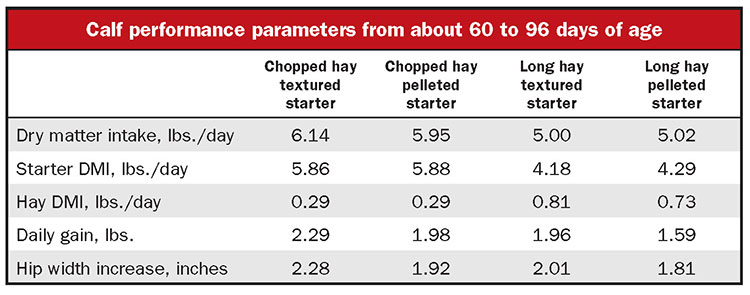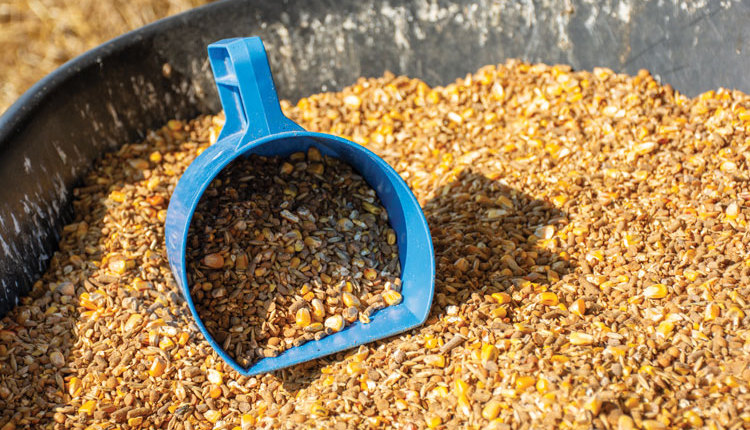I have written before about the weaning transition program — two weeks before and two weeks after full weaning (“Win at weaning; jump-start the rumen” October 10, 2018, page 586 and “We need weaning transition periods,” April 10, 2019, page 230). The feeding change is too often from a calf starter to a mixed feed of some sort, along with free-choice forage, if forage was not being fed before.
If too much forage is fed too soon, gut fill can accumulate and confound true growth measurements. For example, calves were fed only a poorly textured calf starter in a study and were allowed to eat hay free choice. At 10 weeks of age, the calves allowed to eat hay did have improved rumen pH from 5.06 to 5.49, but they also had 10.4 pounds more gut fill. This resulted in less true body growth.
In another study, calves had been weaned at 50 days of age. From 8 to 12 weeks, calves were fed either a 71% forage total mixed ration (TMR), 15% chopped grass hay blended with starter, or only a texturized starter. Intake was 35% less in TMR-fed calves and daily gain was 40% less when compared to the other two treatments, which did not differ.
Is there a happy medium for the introduction of forage?
With these results in mind, a study by the Provimi Nurture Research Center tried to tease out more data on the best way to introduce forage. They fed weaned Holstein steers with initial body weights of 150 pounds at the age of 58 to 59 days. There were two trials with 48 calves per trial and four calves per group pen. There were four treatments with 12 calves per group.
The four feeding groups were:
- Starter with low starch (8%) and pelleted (~16% as-fed) physical form blended with 5% chopped hay, which averaged 12.9% crude protein (CP) as-fed. It was fed free choice.
- High-starch (45%) textured starter blended with 5% chopped hay. It was fed free choice.
- Low-starch pelleted starter limit fed to 4.4 pounds dry basis daily with free-choice long grass hay.
- High-starch textured starter fed up to 4.4 pounds dry basis with free-choice long grass hay.
Water was available free choice to all groups. Total dry matter intake (DMI) and starter DMI (Table) were lower in the long hay treatments while hay DMI was greater in the long hay treatments. This partially is a result of starter DMI restriction at 4.4 pounds daily. Therefore, it might be expected that calves would then consume more free-choice long hay.
Daily gain was greater for the chopped hay treatments and for textured versus pelleted starter treatments. Likewise, hip width (reflecting bone growth) was greater for chopped hay and textured starter treatments. Calves fed the chopped hay treatments also had increased body condition scores, but these were not different for the two starter treatments.
In trials like this, it would have been good to have had gut fill measures. Unfortunately, the best way to obtain that measure is by slaughter, which is not an option in most calf trials.

Slowly introduce hay
Looking at all the data, more gut fill occurred when long hay was fed. Additionally, greater long hay reduced starter intake and resulted in lower daily gain and hip width.
Notice that both daily gain and hip width declined for pelleted versus textured starter treatments. This is indicative that too much forage too soon is not well-handled by calves within this age range.
In months 3 and 4 following weaning, calves did not perform as well when allowed to have free-choice long hay versus limited chopped hay, as it reduced daily gain and bone growth. That also likely created more gut fill, which distorts true body growth as measured by daily gain.
In addition, this study found that pelleted starter (grower) versus textured starter reduced intake, daily gain, and hip width bone growth. It is best to limit hay intake to about 0.5 to 1 pound in the month after weaning, to chop the hay, and to use a textured versus a pelleted starter.











